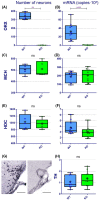Histamine in murine narcolepsy: What do genetic and immune models tell us?
- PMID: 34672414
- PMCID: PMC8877734
- DOI: 10.1111/bpa.13027
Histamine in murine narcolepsy: What do genetic and immune models tell us?
Abstract
An increased number of histaminergic neurons, identified by labeling histidine-decarboxylase (HDC) its synthesis enzyme, was unexpectedly found in patients with narcolepsy type 1 (NT1). In quest for enlightenment, we evaluate whether an increase in HDC cell number and expression level would be detected in mouse models of the disease, in order to provide proof of concepts reveling possible mechanisms of compensation for the loss of orexin neurons, and/or of induced expression as a consequence of local neuroinflammation, a state that likely accompanies NT1. To further explore the compensatory hypothesis, we also study the noradrenergic wake-promoting system. Immunohistochemistry for HDC, orexin, and melanin-concentrating hormone (MCH) was used to count neurons. Quantitative-PCR of HDC, orexin, MCH, and tyrosine-hydroxylase was performed to evaluate levels of mRNA expression in the hypothalamus or the dorsal pons. Both quantifications were achieved in genetic and neuroinflammatory models of narcolepsy with major orexin impairment, namely the orexin-deficient (Orex-KO) and orexin-hemagglutinin (Orex-HA) mice respectively. The number of HDC neurons and mRNA expression level were unchanged in Orex-KO mice compared to controls. Similarly, we found no change in tyrosine-hydroxylase mRNA expression in the dorsal pons between groups. Further, despite the presence of protracted local neuroinflammation as witnessed by the presence of reactive microglia, we found no change in the number of neurons nor the expression of HDC in Orex-HA mice compared to controls. Importantly, no correlation was found in all conditions between HDC and orexin. Our findings indicate that, in mice, the expression of histamine and noradrenalin, two wake-promoting systems, are not modulated by orexin level whether the lack of orexin is constitutive or induced at adult age, showing thus no compensation. They also show no recruitment of histamine by local neuroinflammation. Further studies will be needed to further define the role of histamine in the pathophysiology of NT1.
Keywords: hypocretin; hypothalamus; orexin; sleep.
© 2021 The Authors. Brain Pathology published by John Wiley & Sons Ltd on behalf of International Society of Neuropathology.
Conflict of interest statement
The authors have no conflict of interest to declare.
Figures



Similar articles
-
Histamine Transmission Modulates the Phenotype of Murine Narcolepsy Caused by Orexin Neuron Deficiency.PLoS One. 2015 Oct 16;10(10):e0140520. doi: 10.1371/journal.pone.0140520. eCollection 2015. PLoS One. 2015. PMID: 26474479 Free PMC article.
-
Increase of histaminergic tuberomammillary neurons in narcolepsy.Ann Neurol. 2013 Dec;74(6):794-804. doi: 10.1002/ana.24019. Ann Neurol. 2013. PMID: 24006291
-
Orexin/Hypocretin and Histamine Cross-Talk on Hypothalamic Neuron Counts in Mice.Front Neurosci. 2021 May 20;15:660518. doi: 10.3389/fnins.2021.660518. eCollection 2021. Front Neurosci. 2021. PMID: 34093114 Free PMC article.
-
Interactions of the orexin/hypocretin neurones and the histaminergic system.Acta Physiol (Oxf). 2015 Feb;213(2):321-33. doi: 10.1111/apha.12432. Epub 2014 Dec 29. Acta Physiol (Oxf). 2015. PMID: 25484194 Review.
-
Precocious puberty in narcolepsy type 1: Orexin loss and/or neuroinflammation, which is to blame?Sleep Med Rev. 2022 Oct;65:101683. doi: 10.1016/j.smrv.2022.101683. Epub 2022 Sep 10. Sleep Med Rev. 2022. PMID: 36096986 Review.
Cited by
-
Larger hypothalamic volume in narcolepsy type 1.Sleep. 2023 Nov 8;46(11):zsad173. doi: 10.1093/sleep/zsad173. Sleep. 2023. PMID: 37463428 Free PMC article.
-
Microglia and Sleep Disorders.Adv Neurobiol. 2024;37:357-377. doi: 10.1007/978-3-031-55529-9_20. Adv Neurobiol. 2024. PMID: 39207702 Review.
References
-
- Peyron C, Faraco J, Rogers W, Ripley B, Overeem S, Charnay Y, et al. A mutation in a case of early onset narcolepsy and a generalized absence of hypocretin peptides in human narcoleptic brains. Nat Med. 2000;6:991–7. - PubMed
-
- Mignot E, Lammers GJ, Ripley B, Okun M, Nevsimalova S, Overeem S, et al. The role of cerebrospinal fluid hypocretin measurement in the diagnosis of narcolepsy and other hypersomnias. Arch Neurol. 2002;59:1553–62. - PubMed
-
- Bassetti CLA, Adamantidis A, Burdakov D, Han F, Gay S, Kallweit U, et al. Narcolepsy—clinical spectrum, aetiopathophysiology, diagnosis and treatment. Nat Rev Neurol. 2019;15:519–39. - PubMed
-
- Barateau L, Liblau R, Peyron C, Dauvilliers Y. Narcolepsy type 1 as an autoimmune disorder: evidence, and implications for pharmacological treatment. CNS Drugs. 2017;31:821–34. - PubMed
Publication types
MeSH terms
Substances
LinkOut - more resources
Full Text Sources
Research Materials

